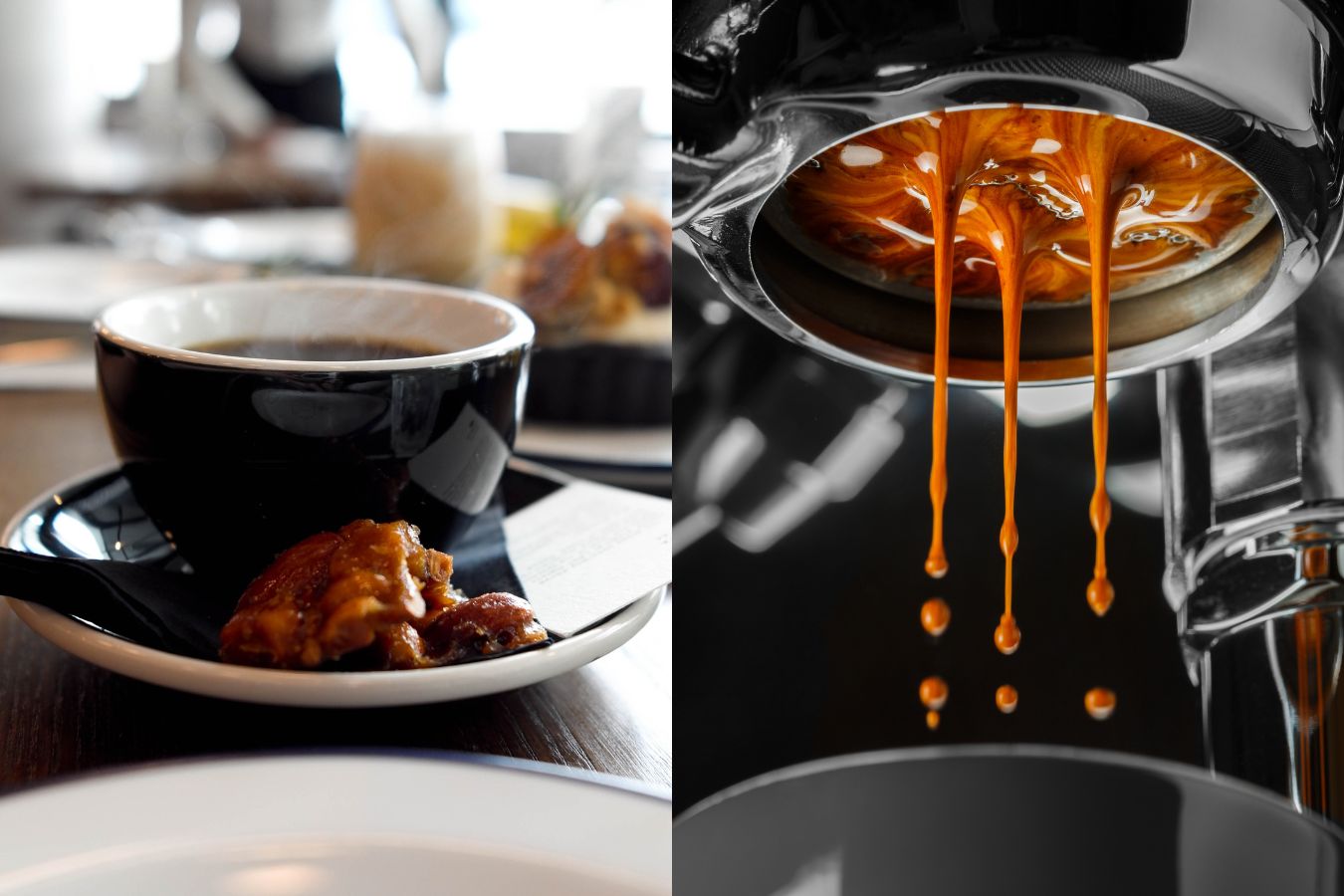Why Brew Lovers Prefer SOE Single Origin Espresso for Purity
Checking Out the Abundant Flavors of Coffee Beans: a Deep Dive Into Coffee and Blended Coffee Beans
When you discover the abundant flavors of coffee beans, you reveal a complicated globe where each range brings its own character to your mug. Recognizing the beginnings, processing approaches, and toasting techniques can change your coffee experience. As you browse through the art of coffee and the imagination behind mixed coffees, you'll start to value the nuances that make each sip one-of-a-kind. What you'll uncover next might transform the means you appreciate your early morning brew.
The Beginnings of Coffee Beans: Checking Out Terroir and Flavor Profiles
When you take a sip of coffee, you're not simply delighting in a beverage; you're experiencing a rich tapestry of tastes shaped by the beans' beginnings. Each region generates special taste profiles affected by dirt, altitude, and environment. Beans from Ethiopia commonly burst with brilliant, fruity notes, while those from Colombia tend to use a well balanced, nutty sweetness.
As you check out various beginnings, you'll discover exactly how terroir-- the ecological elements impacting a plant-- plays a vital function - Single Origin Espresso. The very same coffee selection can taste considerably different depending upon where it's expanded
When you take into consideration these factors, you begin to appreciate the intricacy behind your mug. Each sip tells a tale of the land and the farmers that supported the beans. So, next time you indulge, think of the journey your coffee took before it reached your hands, and enjoy those complex tastes that mirror its beginning.
Comprehending Espresso: The Art and Science Behind the Brew
When you consider espresso, it's not simply concerning the solid flavor; it's also about the strategies that bring it to life. Recognizing exactly how different preparation approaches influence taste can transform your developing experience. Let's explore the ins and outs of espresso prep work and reveal the special flavor accounts that make each cup special.
Coffee Preparation Techniques
Coffee preparation is both a scientific research and an art, integrating accurate techniques with a deep understanding of coffee. To begin, you'll want to choose top quality, freshly baked beans and grind them finely for excellent extraction (Single Origin Espresso). The work size is essential; also crude, and your coffee will certainly be weak, as well great, and it'll be bitter
Next, tamp the grounds equally in the portafilter to guarantee uniform extraction. When you lock it into the device, aim for a developing temperature in between 190 ° F and 205 °
F.As you pull the shot, expect the excellent extraction time-- around 25-30 secs. The result needs to be a rich, luscious espresso with a gorgeous layer of crema ahead. With method, you'll master these methods.
Taste Profiles Clarified
The world of coffee supplies a rich tapestry of taste accounts that can elevate your coffee experience. When you take that initial sip, you'll notice a balance of resentment, level of acidity, and sweet taste. Each coffee bean lugs special notes, from flower and fruity to nutty and chocolaty. Light roasts often showcase intense level of acidity and vibrant flavors, while dark roasts present much deeper, bolder tones.
Comprehending these profiles assists you choose the best espresso for your palate. Try out different blends can reveal surprising mixes. As an example, a well-crafted blend might harmonize the bright notes of an Ethiopian bean with the abundant, chocolatey touches of a Brazilian bean. Embrace the journey of uncovering espresso's diverse tastes, and you'll change your coffee ritual into an amazing journey.
Handling Methods: How They Impact Taste and Aroma
While it could appear that the origin of coffee beans is one of the most considerable element in determining their taste and scent, the processing approaches utilized post-harvest play an equally important duty. You'll locate that these approaches can considerably modify the last taste profile of your cup.
For circumstances, the washed procedure eliminates the fruit from the beans before fermentation, commonly bring about a cleaner, brighter taste. The natural procedure leaves the fruit intact throughout drying, resulting in a sweeter, fruitier account.
Other techniques, like honey handling, strike a balance, permitting some fruit mucilage to remain, giving a distinct intricacy.
Each processing method interacts with the beans' intrinsic characteristics, improving or silencing specific flavors and fragrances. When you sip that coffee or combined coffee, remember that the journey from cherry to mug is affected not simply by origin but likewise by just how those beans were refined.
Roasting Methods: Opening the Complete Potential of Coffee Beans
Roasting methods are essential for revealing the full capacity of coffee beans, as they change raw, environment-friendly beans right into the aromatic, flavorful coffee you delight in. The option of toasting approach-- light, medium, or dark-- dramatically influences flavor profiles. Light roasts preserve the beans' natural acidity and fruity notes, while medium roasts balance sweetness and richness. Dark roasts, on the other hand, highlight strong, smoky flavors.
A slower roast at reduced temperatures permits for intricate flavors to create, while a quicker roast can heighten bitterness. By understanding these methods, you'll reveal a globe of flavor, boosting your coffee experience to new elevations.
The Magic of Blended Coffee: Developing Special Flavor Experiences
Producing a special flavor experience with combined coffee can transform your early morning ritual right into an exploration of preference. By combining various beans from various areas, you can reveal a harmony of flavors that raise your mug to brand-new heights. Each mix offers a distinct profile, balancing level of acidity, sweetness, and body to produce something really unique.
When you choose a blend, you're not simply picking a coffee; you're choosing a trip across diverse landscapes and societies. Experimenting with different mixes permits you to discover your individual faves, whether you delight in fruity notes or rich, chocolatey touches.

Sampling Notes: Identifying the Subtleties in Your Cup
As you drink your coffee, you could notice a spectrum of flavors dancing on your taste buds, each exposing the details of the beans. You might taste the bright level of acidity reminiscent of citrus or the deep, rich notes similar to dark chocolate. The sweet taste might stimulate honey or sugar, stabilizing the total find here account magnificently.
Pay focus to the body of the coffee-- does it feel airy and light, or is it full and velvety? The surface, as well, uses hints; a sticking around aftertaste might mean nuttiness or floral undertones.

Don't forget to check out the one-of-a-kind characteristics of different beginnings, as each area imparts distinct flavors - Single Origin Espresso. For example, Ethiopian coffees have a peek at these guys commonly present fruity notes, while Colombian beans might display an extra rounded sweetness. By identifying these nuances, you'll deepen your admiration for each and every cup, elevating your coffee experience to brand-new elevations

Developing Techniques: Taking Full Advantage Of Flavor Removal for every single Bean
When you discover the different developing techniques, you'll discover that each strategy can substantially impact the taste profile of your coffee. From French press to pour-over, each approach essences different substances, enhancing or silencing particular notes. Using a French press enables oils to remain in the brew, developing a richer taste, while pour-over stresses clarity and brightness.
Temperature and grind dimension also play essential duties. A coarser grind works best for chilly mixtures, while a fine work is perfect for coffee. Explore water temperature level-- in between 195 ° F and 205 ° F-- can reveal concealed tastes, also.
Don't neglect regarding soaking time; a quick removal can lead to sour notes, while over-extraction may produce bitterness. By changing these variables, you can make best use of flavor extraction and genuinely boost your coffee experience. Delight in the journey of uncovering what approach best matches your taste!
Regularly Asked Questions
What Is the Suitable Water Temperature for Developing Coffee?
The excellent water temperature for brewing coffee's between 195 ° F and 205 ° F. If you use water that's also hot, you'll over-extract tastes; too cold, and you won't remove sufficient. Go for that sweet spot for the finest brew!
Just How Does Work Dimension Influence Coffee Taste?
Work dimension substantially affects coffee taste. Better grinds remove a lot more tastes and oils, causing a bolder preference, while coarser grinds return a lighter flavor. Changing grind size helps you attain your desired coffee profile.
Are There Health Advantages Related To Drinking Coffee?

What Is the Distinction In Between Arabica and Robusta Beans?
Arabica beans are smoother and sweeter, commonly featuring fruity flavors, while robusta beans are more powerful with a bitter preference and higher high levels of caffeine content. You'll see these distinctions in scent and brewing experience.
Just How Can I Shop Coffee Beans for Freshness?
To save coffee beans for freshness, keep them in an impermeable container, away from heat, light, and dampness. You'll preserve their taste much longer if you only grind what you require right prior to brewing.
Discovering the Rich Tastes of Coffee Beans: a Deep Dive Into Espresso and Blended Coffee Beans.
When you discover the rich tastes of coffee beans, you discover a complex globe where each range brings its very own character to your mug.When you take a sip of coffee, you're not just appreciating a drink; you're experiencing an abundant tapestry of flavors shaped by the beans' beginnings.Roasting techniques are essential for disclosing web the full capacity of coffee beans, as they change raw, eco-friendly beans right into the aromatic, savory coffee you delight in.As you drink your coffee, you might observe a range of flavors dancing on your taste, each revealing the ins and outs of the beans.